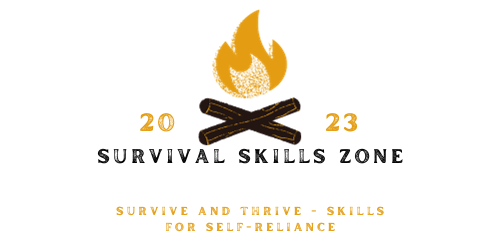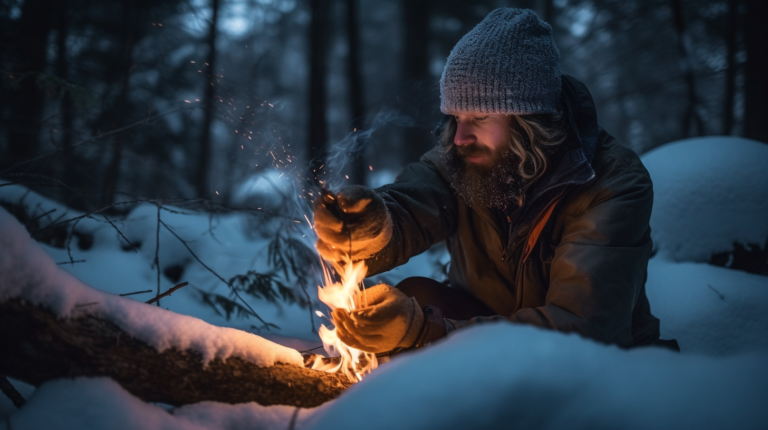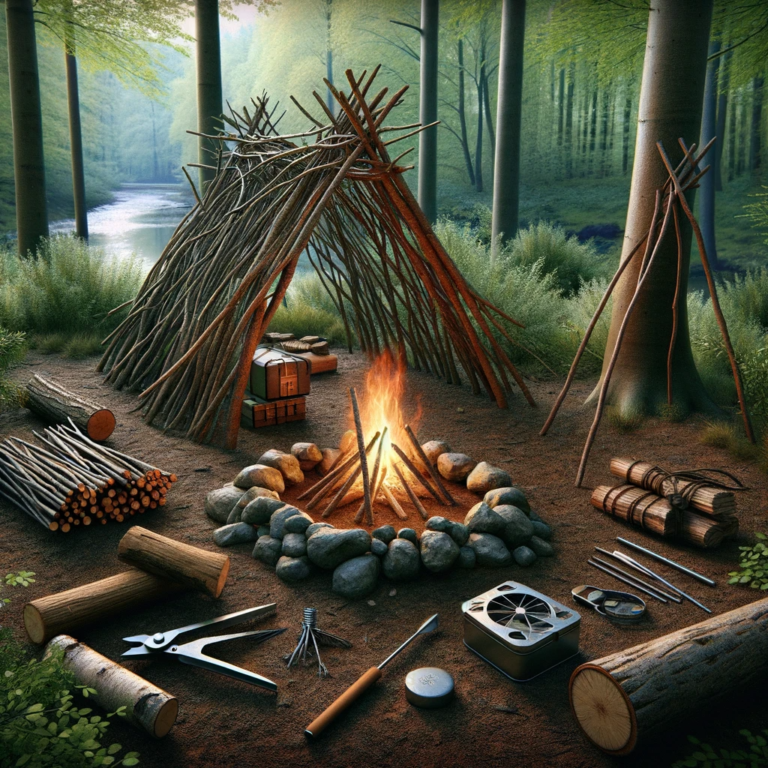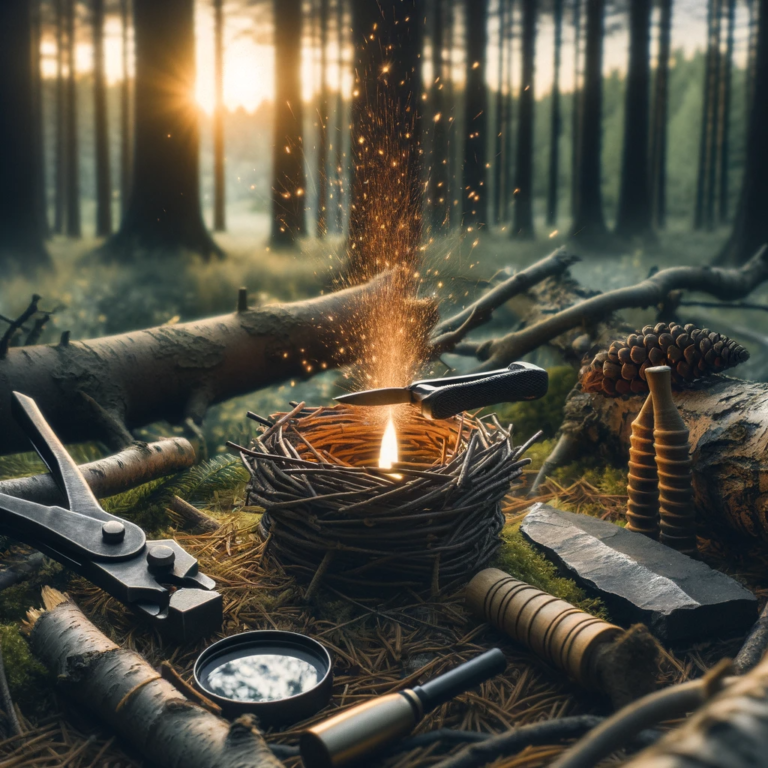Stay Warm or Perish: Unconventional Fire-Starting Survival Secrets
Unconventional Fire-Starting Survival Secrets: In the days of yore, your ancestors sparked flames with flint; now, it’s your turn to master the art of fire without modern crutches. ‘Stay Warm or Perish: Unconventional Fire-Starting Survival Secrets’ empowers you with the knowledge to ignite a life-saving warmth when technology fails.
You’ll learn how to coax flames from the most unlikely materials—think chips, batteries, even ice—ensuring your freedom from reliance on conventional methods. Through understanding friction-based techniques, chemical reactions, and solar power solutions, you’ll be equipped to face the cold embrace of nature with confidence.
This guide isn’t just about survival; it’s about claiming the independence to control your warmth, your safety, and ultimately, your destiny.
Key Takeaways
- Solar-based fire-starting techniques such as using a magnifying glass or DIY solar collectors can be effective in igniting tinder.
- Chemical reactions using substances like potassium permanganate and glycerin, or everyday items like cotton balls and petroleum jelly, can also be used to start fires.
- Friction-based techniques like the fire bow drill, gathering and smoldering sawdust, can generate heat and create a flame.
- Unconventional fire-starting techniques like using a gum wrapper and battery terminals, snacks like greasy potato chips and hand sanitizer as accelerants, or creating a makeshift torch using potato chips can be useful in emergency situations.
The Lens Method
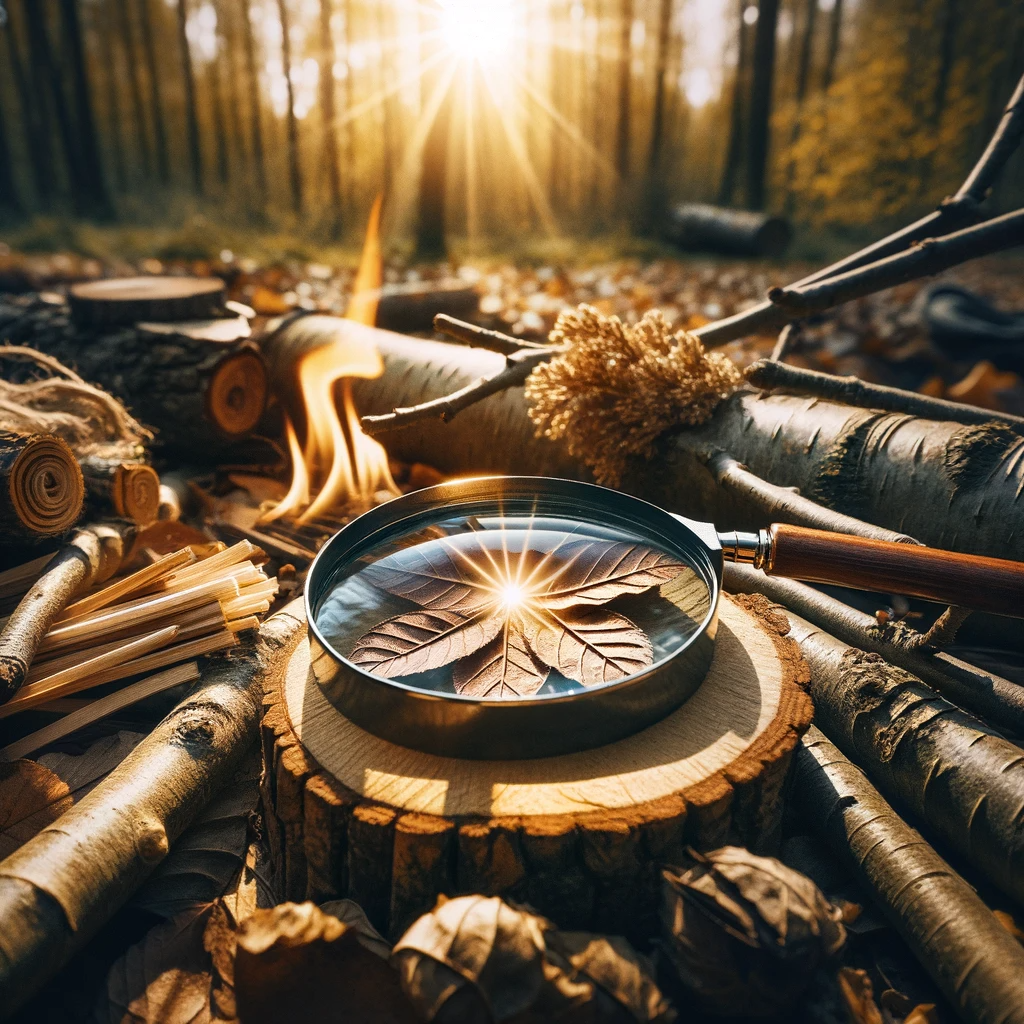
Your survival kit’s magnifying glass can become a lifesaving tool when you harness the sun’s rays to ignite a fire. This method isn’t only practical but has stood the test of time, offering a dependable solution when you’re stripped of conventional means. It’s paramount that you master this skill to ensure your freedom and safety in the wild.
First, gather your tinder—dry materials are crucial. Search for fine, fluffy fibers like dry grass, leaves, or even shredded paper that can easily catch a spark. Once you’ve prepared your tinder nest, hold the magnifying glass between the sun and the dry materials. Angle it to focus a pinpoint of light onto your tinder. Be patient; it may take a few moments for the heat to build and the tinder to smolder.
With steady hands and a keen eye, adjust the distance of the magnifying glass to achieve the smallest, most intense spot of light. As the focused sun’s rays heat the material, you’ll notice smoke rising, signaling the impending birth of a flame.
Remember, mastery of this technique adds a reliable edge to your survival skills—especially when modern gadgets fail.
Up next, let’s explore how chemical reactions can also serve as a critical ally in your quest for fire.
Chemical Reactions
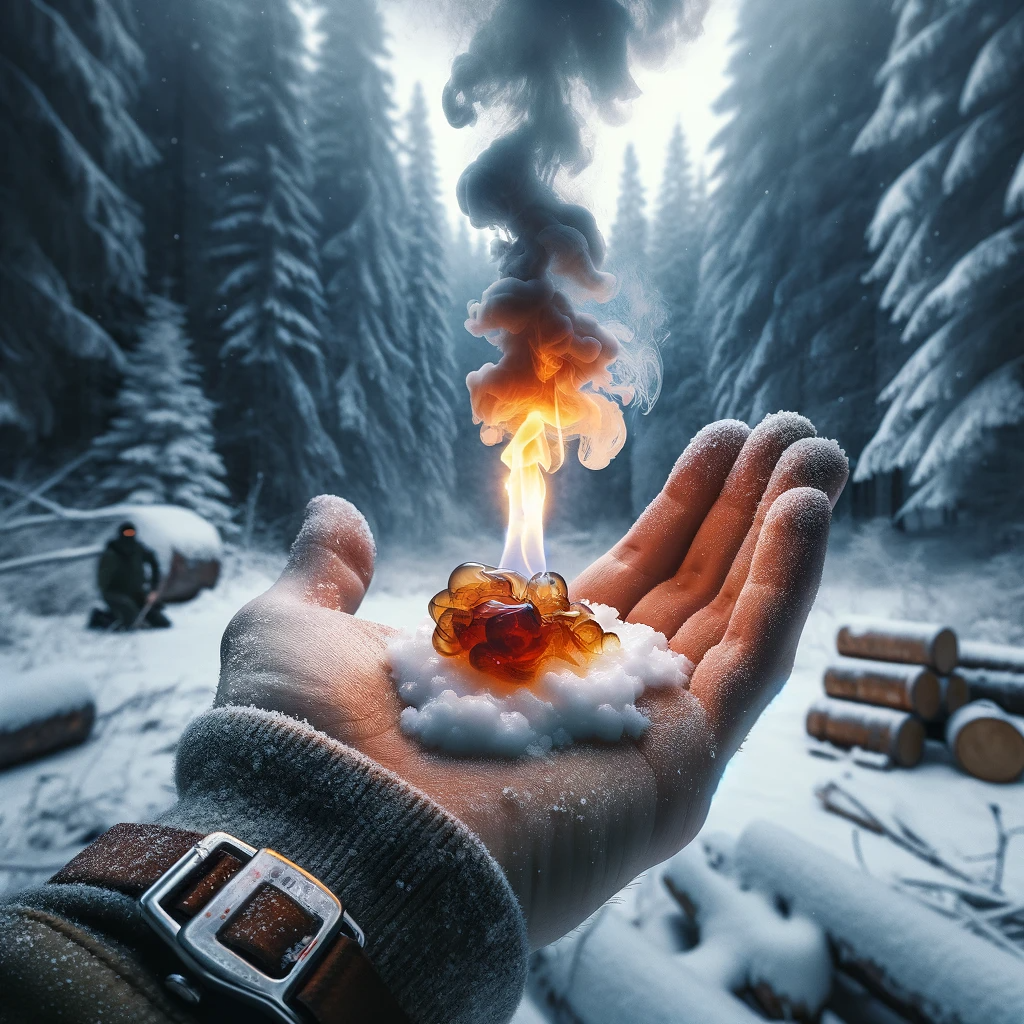
Harnessing nature’s prowess with the lens method is just one facet of survival; now, let’s delve into how chemical reactions can be your next indispensable tool for igniting a life-saving fire.
Chemical fire-starting is an art that demands respect for its volatility but rewards you with a flame when conventional methods fail.
For a reliable and potent reaction:
- Mix potassium permanganate with glycerin. The reaction is exothermic, producing enough heat to set tinder ablaze.
- Safety tip: Handle with care, as this mixture ignites rapidly.
- Preparation: Combine these chemicals only when you’re ready to light up.
- Efficiency: A small amount can yield a significant flame.
In your quest for autonomy, you’ll find that everyday items can become extraordinary tools. Cotton balls, for instance, when slathered in petroleum jelly, transform into a slow-burning tinder that defies damp conditions. Meanwhile, fine steel wool isn’t just for scouring pots—it reacts fervently when connected to a battery, creating a sizzle that catches fire to your kindling.
Master these methods, and you’ll wield the power to conjure fire from the unlikeliest of sources, a true testament to your resourcefulness and will to thrive against the odds.
Friction-Based Techniques
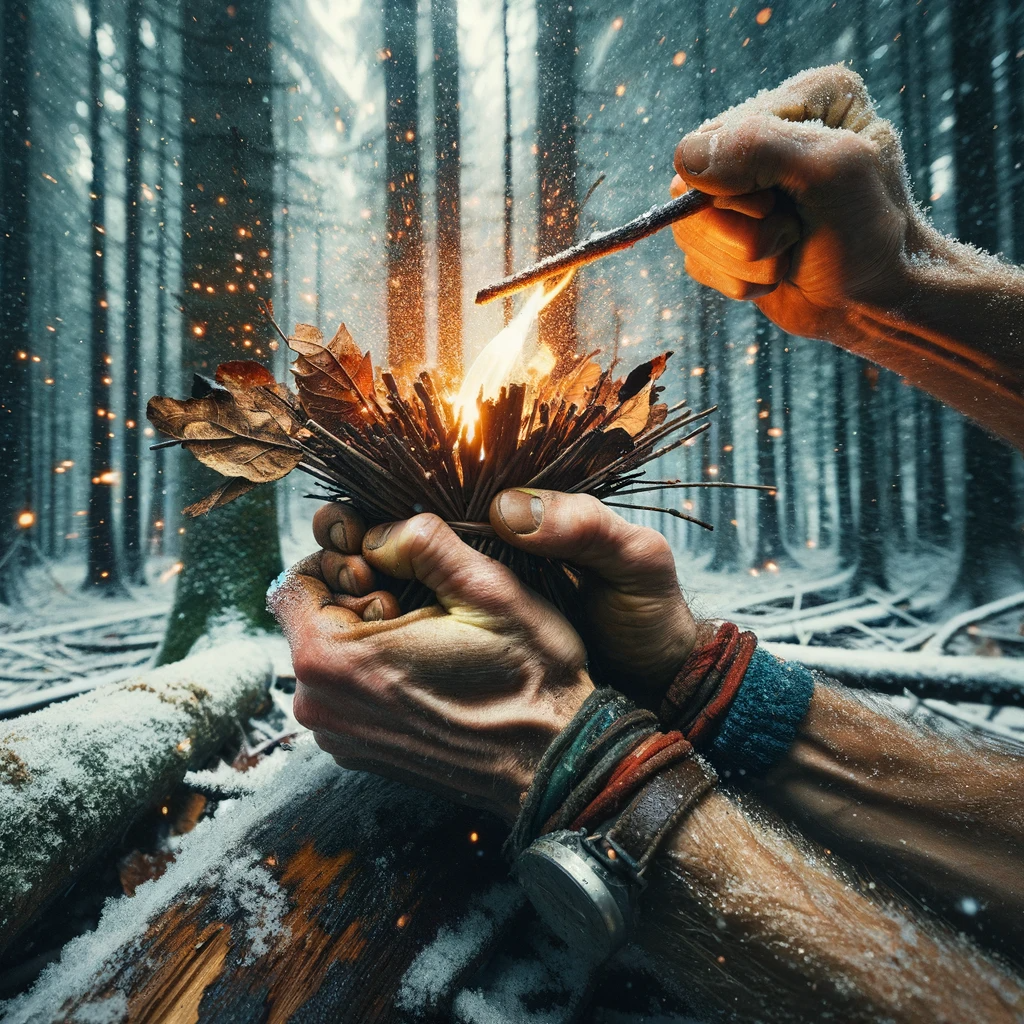
While chemical reactions offer a potent means to ignite flames, you’ll also find salvation in the primal art of friction-based fire starting methods. The technique is simple yet profound: you must rely on friction. You’re not just rubbing two sticks together aimlessly; there’s a method to this ancient madness.
First, you need a fire bow drill. This is a bow-shaped tool that rapidly spins a drill against a baseboard, generating enough heat through friction to create an ember. It’s crucial that you select the right wood—softwood is your best bet for both the drill and baseboard.
To start, create a small depression in your baseboard and place your drill inside it. Now, use the bow to rotate the drill swiftly. You’re seeking the sweet spot between speed and pressure; too little, and you won’t generate enough heat; too much, and you’ll exhaust yourself without seeing a single spark.
As you work the drill, you’ll gather a pile of fine sawdust. Once it smolders, carefully transfer this ember to your tinder—this could be anything from dried grass to the lint in your pockets. Blow gently, feeding the ember until it bursts into flame, giving you the freedom to conquer the cold.
Improvised Battery Tricks
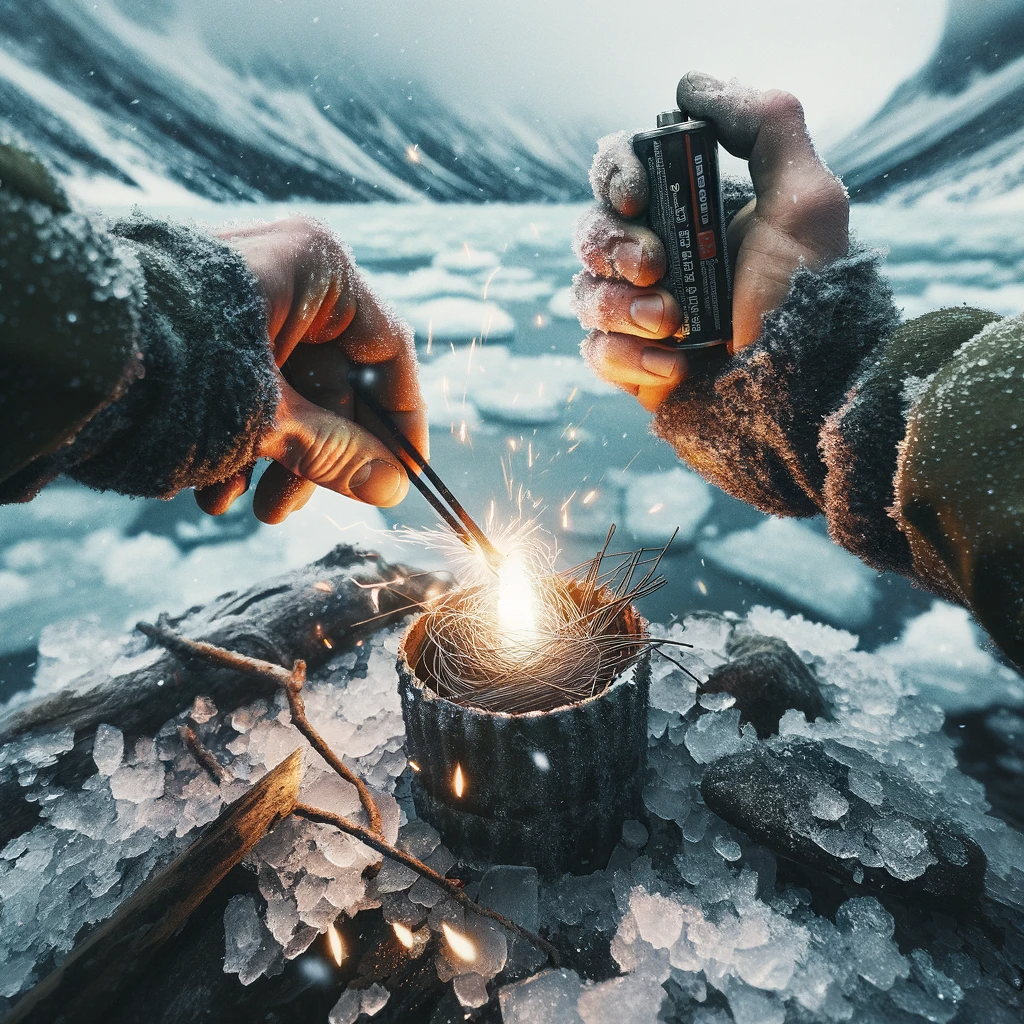
In survival situations, you can turn a common 9-volt battery into a life-saving fire starter by employing a bit of ingenuity. Here’s how you harness one of the most practical battery tricks to keep warm:
- Grab your steel wool. It should be fine grade, as coarser wool mightn’t ignite as easily.
- Tease apart the wool to increase its surface area—this helps it catch a spark.
- Press the steel wool against both terminals of the battery. The electrical current will cause the steel wool to heat up and glow.
Once you’ve got the glow, you’re on your way to starting a fire. But don’t stop there; optimize your chances with these steps:
- Prepare Your Tinder:
- Blend the glowing steel wool with your gathered tinder.
- Ensure the tinder is dry and fluffy for the best chance of ignition.
- Safety Precautions:
- Keep your battery and steel wool separate until use.
- Handle with care to avoid short-circuiting or overheating the battery.
- Enhance the Flame:
- Consider adding wax to your tinder for a longer-lasting flame.
- Alcohol-soaked corks can also serve as extended burn tinder.
Solar Power Solutions
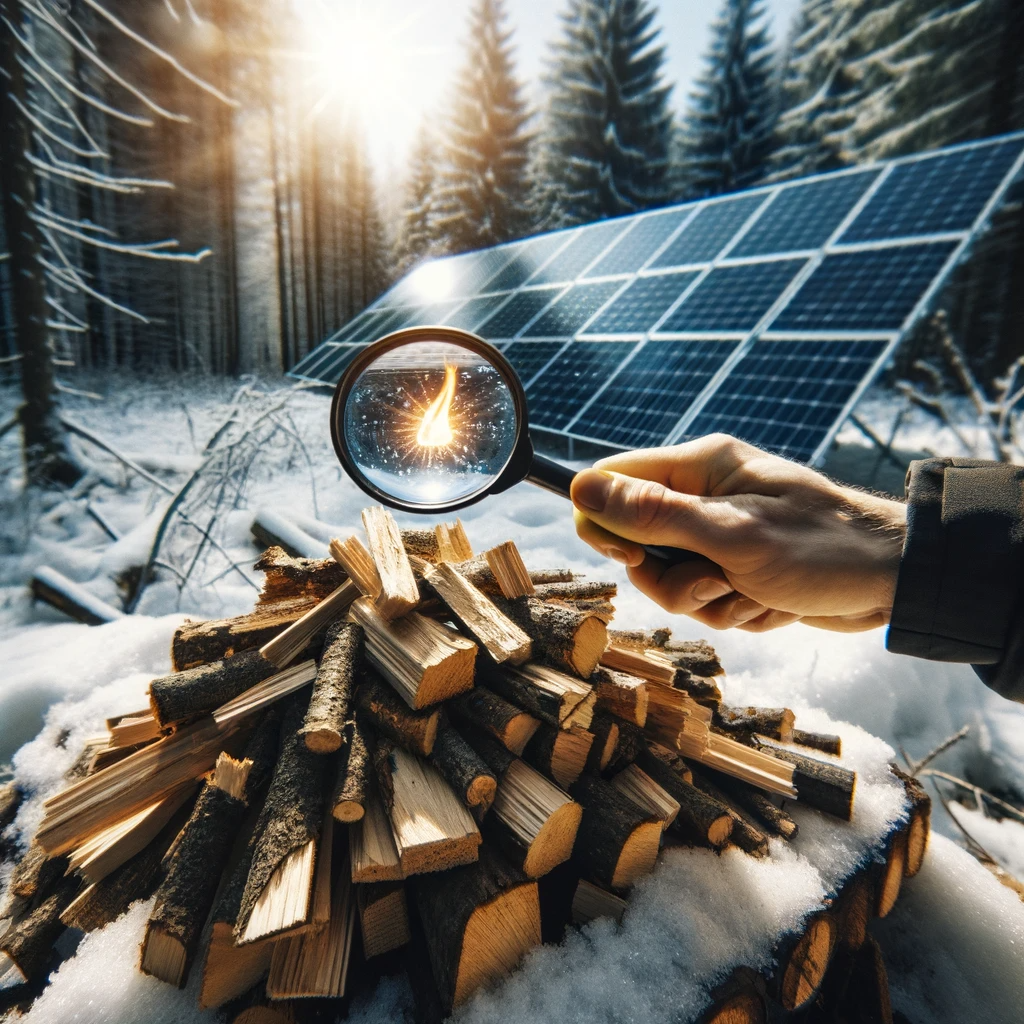
You’re in the wilderness and your matches are soaked—no problem if you’ve mastered solar ignition techniques.
With items like a magnifying glass or even a clear water bottle, you can harness the sun’s rays to spark a flame.
We’ll also explore how compact solar devices and DIY solar collectors can become vital components in your fire-starting toolkit.
Solar Ignition Techniques
Harnessing the sun’s rays, you can initiate a fire through innovative solar ignition techniques that expand your survival toolkit. These alternative methods are essential survival skills that bolster your independence in the wild.
- Magnification Tools:
- Magnifying Glass: Direct sunlight through the lens to a precise point on your tinder.
- Clear Water Bottle: Fill with clear water to focus the sun’s energy.
- Ice Lens: Shape clear ice into a makeshift magnifying lens.
Potassium permanganate mixed with glycerin, when exposed to sunlight, creates a chemical reaction fiery enough for ignition. Mastering these techniques ensures you’re never without the means to kindle a flame.
As you refine your solar ignition skills, consider advancing to the next level by crafting your own diy solar collectors.
DIY Solar Collectors
Building your own DIY solar collector is a straightforward way to leverage the sun’s energy for fire-starting in survival situations. You’re not just gaining independence; you’re equipping yourself with a tool that doesn’t rely on conventional fuel sources.
With some basic materials, you can construct a device that focuses sunlight onto combustible material, igniting it without a flame. This solar power solution is more than a novelty—it’s a reliable survival fire starter that adds a layer of safety to your preparedness.
In the face of adversity, your ability to start fires using the power of the sun could be the edge that keeps you warm and alive. Embrace this skill, for it embodies the resilience and self-sufficiency that define true freedom.
Compact Solar Devices
Why settle for traditional fire-starting methods when compact solar devices can provide a sustainable and innovative solution in your time of need? These devices aren’t just for charging gadgets; they’re adaptable fire starters under the right conditions.
Solar power solutions are essential for:
- Fire Starting:
- Harness sunlight to ignite tinder
- Use reflective surfaces as a makeshift solar lighter
- Concentrate beams for a quick flame
They’re lightweight, easy to pack, and, unlike fuel-based starters, won’t run dry. Remember, their effectiveness depends on:
- Clear skies
- Direct sunlight
- Proper angling
Master their use, and you’ve got a fire source that’s only as limited as the daylight.
Now, let’s shift gears to explore unusual flammable substances that can take your fire-starting skills to the next level.
Unusual Flammable Substances
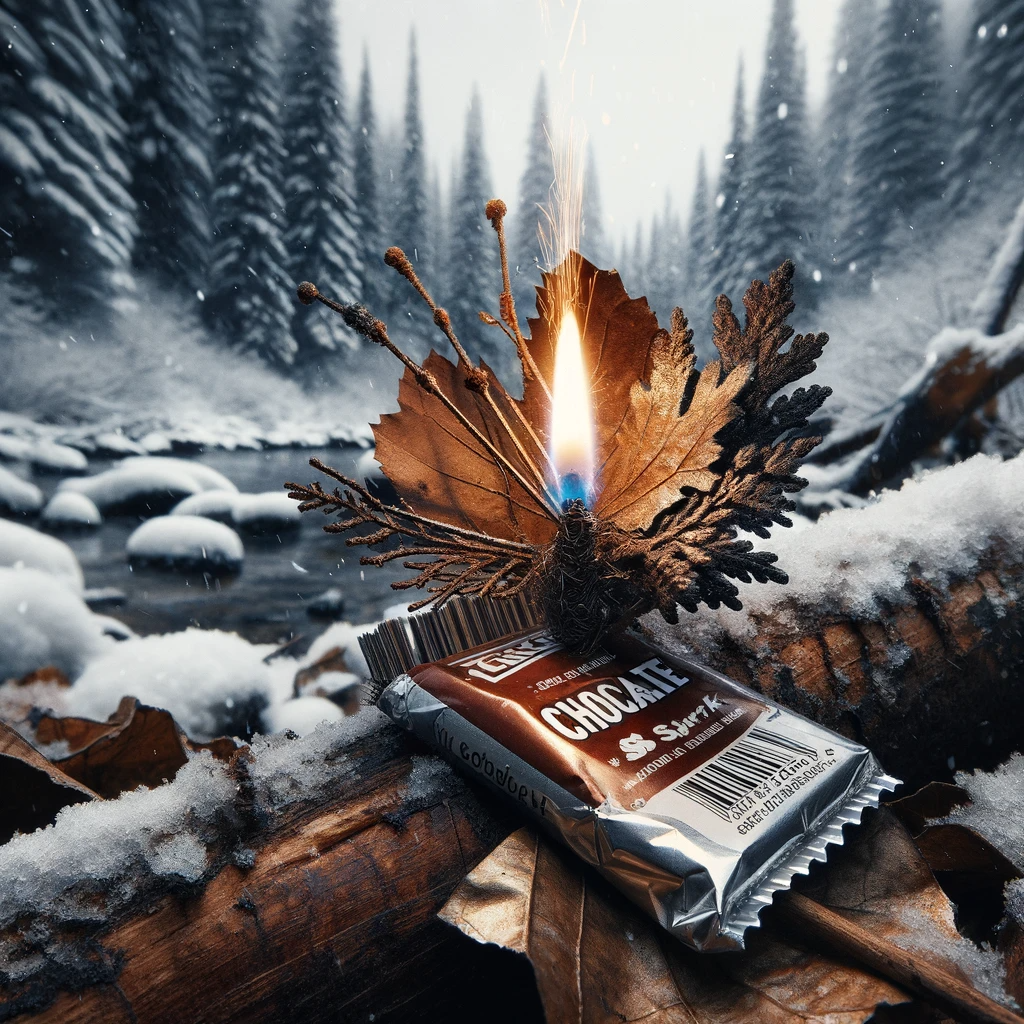
You may not realize it, but your snack stash could save your life in a pinch; greasy potato chips can catch fire easily, creating a makeshift torch in emergency situations.
If you’re sanitizing your hands, you’re also carrying a potential fire starter—hand sanitizer’s high alcohol content makes it highly flammable.
And don’t toss that gum wrapper; the thin foil and paper composition can act as a conductor to spark a flame when paired with a battery.
Potato Chip Flames
In a pinch, potato chips can serve as your unexpected ally, igniting with ease to create a makeshift flame. When you’re aiming to stay warm or signal for help, these greasy snacks offer more than just calories.
Here’s how to make and use them effectively:
- Gather a small pile of chips; the oil content makes them highly combustible.
- Use a birthday candle or lighter to ignite one chip.
- Carefully add more chips to grow the flame.
Start a fire using this unconventional method with caution. Be mindful of the smoke and keep your face clear. Remember, the burn time of potato chips won’t match traditional tinder, but it’ll give you those precious moments to turn a spark into a stable fire.
Embrace this freedom to innovate, even in survival scenarios.
Hand Sanitizer Blaze
Your bottle of hand sanitizer is more than a germ-fighter; it’s a potent fire starter in desperate times. In survival situations, freedom means self-reliance, and that includes knowing how to keep a fire going when conventional means falter.
The alcohol content in hand sanitizer makes it an excellent accelerant. To harness this, apply a small dollop on a cotton ball or other tinder and strike your flint and steel. The spark will ignite the gel, creating a stable flame.
It’s crucial, however, to handle this with care—alcohol flames can be nearly invisible in daylight, posing a risk of burns. Include hand sanitizer in your survival kit; it’s a multipurpose ally, ready to disinfect or help signal rescue with a life-saving fire.
Gum Wrapper Spark
Shifting focus from conventional accelerants, consider the humble gum wrapper as a surprising spark generator for your survival fire-starting needs. When you’re in a pinch, this everyday item can become a lifesaver. Here’s how to make a fire with it:
- Find a battery (AA or AAA works well)
- Cut the gum wrapper into a narrow strip with an hourglass shape
- Touch the ends of the strip to the battery terminals
A gum wrapper spark is born as the thin middle part ignites due to electrical resistance, which can help you light a piece of steel wool or tinder. It’s a powerful reminder of how unconventional methods can secure your freedom to survive.
As we explore further, let’s uncover how to create fire from ice, another surprising survival technique.
Fire From Ice
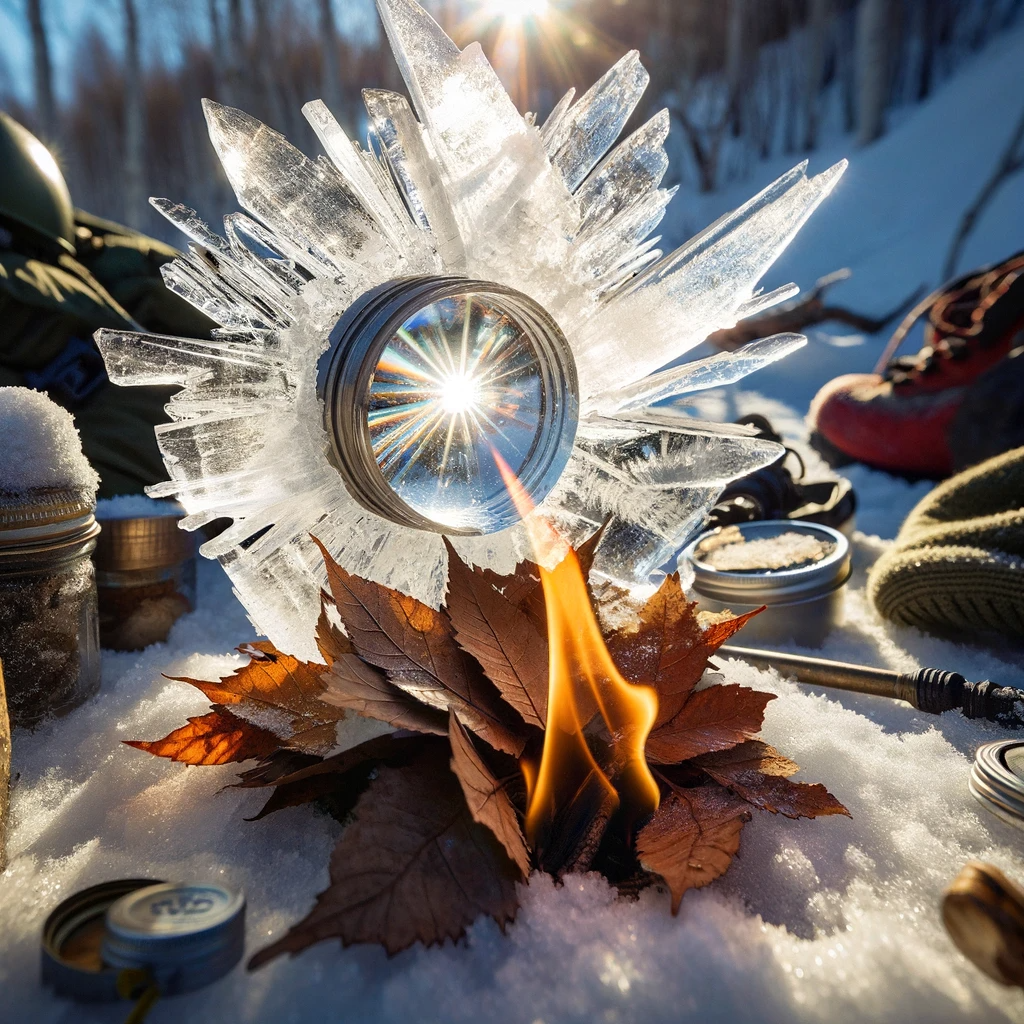
You might find it hard to believe, but a clear piece of ice can become your lifeline by focusing sunlight to start a fire. In the wild, when conventional methods fail, this technique could save your life. Here’s how to harness the power of ice to create a flame.
First, find or craft a lens-shaped piece of ice. It must be transparent and without impurities. Smooth it carefully with your hands or a knife – you’re aiming for the clarity and shape of a magnifying glass. The sun’s rays, when focused through this ice lens, can ignite a pile of natural materials.
Gather dry twigs, leaves, and perhaps some bark – these will serve as your tinder. Position your ice lens above the tinder, making sure the sun is shining directly through it. Angle the ice until you see a bright, concentrated spot on the tinder; that’s your sweet spot.
Be patient, it could take a few minutes, but once the tinder smokes and a flame is born, carefully nurture it. This skill isn’t just a backup fire-starting method, but a testament to your ability to adapt and use what nature provides to claim your freedom from the elements.
Unconventional Fire-Starting Survival Secrets Frequently Asked Questions
What Is the Best Fire Starting Material Survival?
You’ll find alcohol-soaked cotton, a 9-volt battery with steel wool, or homemade wax-lit egg cartons are top-notch materials to start a fire. They’re reliable, easy to use, and could save your life.
What Is the Best Homemade Fire Starter?
You’ll find that alcohol-soaked cotton balls, a 9-volt battery with steel wool, or an egg carton with charcoal are among the best homemade fire starters for efficient, reliable ignition in the wild.
How Do You Start a Fire Survival Technique?
To start a fire, gather small tinder, kindle with chips or charred cloth, and spark it using a battery and steel wool. It’s your right to master these methods, ensuring survival and self-reliance.
What Is the Best Material for a Fire Starter?
The best fire starter material depends on your situation. You’ve got options: alcohol-soaked cotton, steel wool with a battery, or natural tinder like pine needles. Choose wisely to keep that flame alive.
Helpful Links
